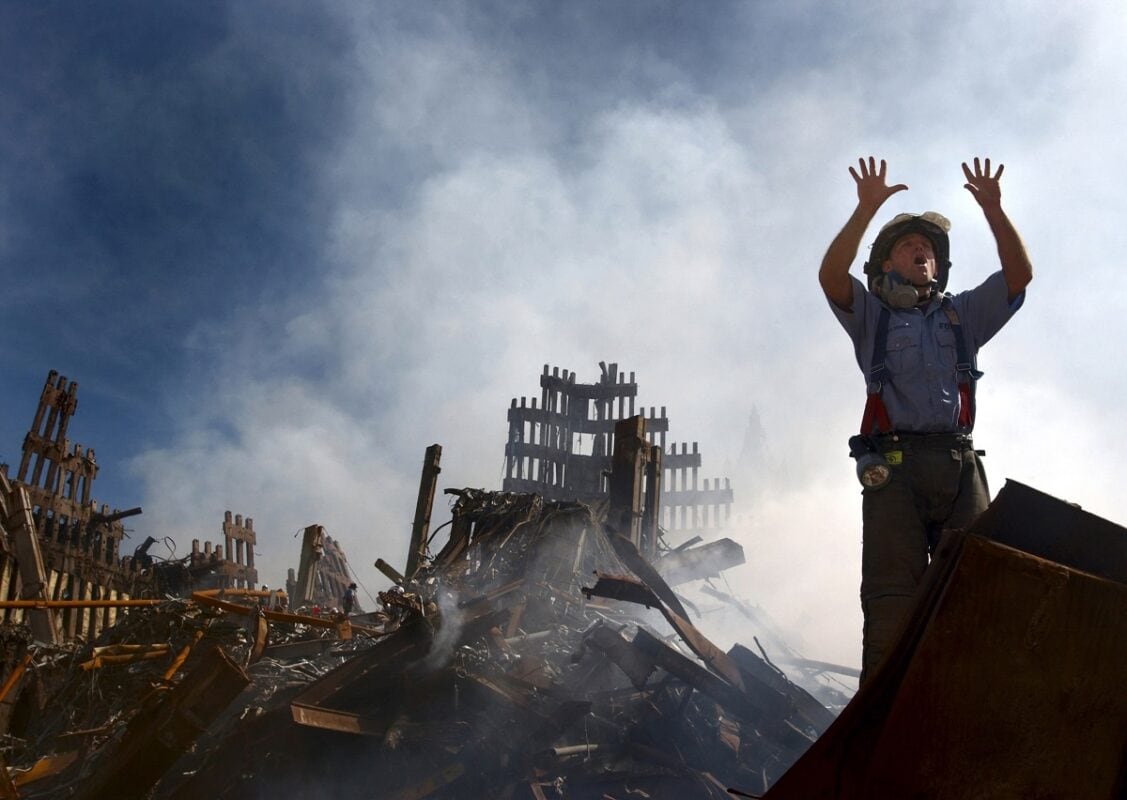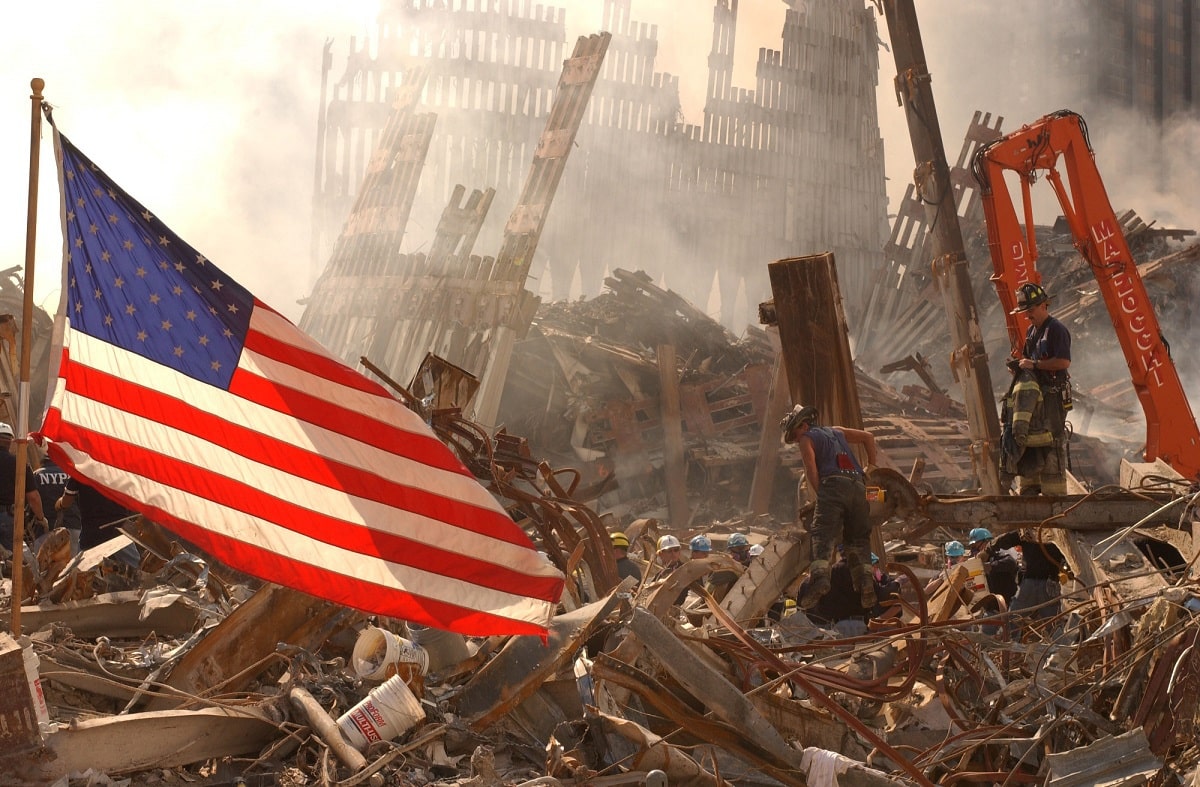My 9/11 Experience: September 11, 2001, started like any other Tuesday, but the world changed that day and my worldview shifted as the towers fell. I was on the street below when the second plane hit, and there are details I can never forget.
When people ask me how I am not scared to do certain things such as fly, when “it can be dangerous,” I say, “If I have to get somewhere I will choose that, and anything can happen at any time, such as when I am crossing the street.” I felt that way pre-9/11, but my point was proven that day when I was crossing the street.
9/11: The Last Subway through Courtland Street Station
While most recounting of the day will start when the first airplane hit the World Trade Center tower, my retelling begins on the 2/3 subway line. I worked in a building across the street from the World Trade Center and took the subway into the concourse level of the complex each morning, then crossed the street to get to my office.
The journey that morning started on the 2/3 express train that ran down Manhattan’s west side. I had an mp3 player blaring through earbuds in my ears and took the subway to Chambers street where I transferred to the local 1 train, just like any morning heading to work.
One side note about New Yorkers and their commutes to work is that you learn where to stand on the platform so the doors open exactly at the exit at your destination. I have been known to miss a train on occasion because I am trying to get to that exact spot rather than settle on getting on the train at another door, on another car, and then have to walk the platform after I get off the train.
I didn’t necessarily experience any of that on 9/11, but the exact spot where I stood on the platform was at the end of the platform, to get on the first car at the second door. At Chambers Street, the platform at that point is narrower, under the stairs, and has a guard rail that stretches the length of the first car that divides the platform. It was awkward, but there were many commuters who, each morning, would exit the 2/3 train, duck under the guard rail, and then get on the 1 train to take it one stop to Chambers Street (or some may have traveled beyond that stop).
On that morning, with my music playing, I got off the 2/3 train, ducked under the guard rail (with a whole carload of other people), and got on the 1 train, then waited for it to go, and waited. An announcement, which I didn’t hear but followed others who heard, said the 1 train was going out of service and to go back to the 2/3 train. We all went across the platform, under the guardrail, back on the original train, and waited. At this point, I may have turned off my music in time to hear the announcement that the 1 train would continue on, so we all crossed the platform yet again and boarded the first car of the train. Doors closed and the train pulled out of the station.
I didn’t know then, but that pause was probably just after the first plane hit, and the MTA didn’t know whether it was safe to continue service. I think that I may have been on the last train to make it through the station until service resumed about 15 years later.
9/11: Concourse Level in Evacuation Mode
When I got off the train at Cortland Street and continued up the stairs I was just starting to notice things were different when my cell phone rang. It was my husband, fellow 19FortyFive writer Peter Suciu, “An airplane crashed into the World Trade Center, get out.”
I noticed that the lighting on the concourse level was down to emergency lighting. Stores had already closed. The normally bustling shopping and business area was a ghost town aside from us straggling commuters emerging from the train.
As I got to the doors to exit, I saw the plaza was carpeted with office and building debris. Ceiling tiles, desk parts, papers, just all kinds of refuse had fallen from the blown-out building. As I approached the planters that divided the plaza from Church Street, I saw a young couple standing and staring at the burning building. Not knowing what kind of plane crashed – at that point I thought it was a private jet that somehow crashed by accident – I did know that jet fuel is explosive. “Keep going, don’t stay here, get out,” I yelled at them as I hustled to the street. Once I crossed the street, I allowed a moment to look up at the building to see hot flames and black smoke billowing from the higher floors.
As I turned to continue half a block to my office entrance it got incredibly loud. The second plane was crashing into the building. I ran, I screamed but didn’t hear myself over the noise, I heard and felt bits of shrapnel whizzing by me. I entered the building without being hit by any flying debris and went upstairs. There was a small group huddled by reception. One of the executives of the financial start-up I worked for said, “We need to wait here until they tell us where we should go.”
My hands curled into fists and through clenched teeth I said,” They don’t want us here, we’re in the way. They have other things to worry about right now.” I went into the internal conference room and called my husband and my father. We agreed my husband would meet me at my father’s office in Herald Square, about half way home. When I went back to the reception area the small group was proceeding toward the stairs. I grouped together with the manager of my department and another coworker and we walked toward the lower east side before we made our way north in order to steer away from the developing mess.
The Journey Home
We were a safe distance away when the first tower collapsed. We stood and watched the historic moment, unsure of how much this changed America, but knowing the significance of the moment. When we were about at 14th street, a rush of dusty people caught up to us and stormed through. Those were the people who got caught in the dust and debris of the collapsing buildings. They pressed through with urgency, and we let them proceed. I made it to my father’s office, had a few sips of water, and continued on toward home.
On a more direct route, I estimate it was just over six miles to get from office to home. Since we walked further east it was likely seven miles or more to walk that day. It was months before I returned to that office. I volunteered a few computers in my apartment for coworkers to come and work for a few days as I had a DSL line that could accommodate several users. We then moved to a temporary space in Tribeca before returning to the location near what was then referred to as the “bathtub,” where rescue and recovery efforts had given way to preparation efforts for construction.
My worldview changed on that day and the days after 9/11. I had previously not been able to fathom war and conflict, but at that moment understood that America had to take action, to do something meaningful to fight this force that wanted to destroy us. I still don’t know whether the actions we took were right. I think it started out on the right path, but then the action became “just going through the motions” and the direction was lost, things weren’t followed through as they should have been. It pains me that it is one year since the chaotic evacuation of Afghanistan, and things are back the way they were, actually worse than they were pre-9/11.
Revisiting the Site of 9/11
I think of 9/11 often throughout the year and always take time to reflect on my experience on the anniversary. My experience was far less than what others endured, but it is significant to me. I no longer live in New York but have had a few occasions to relive the moments, to mark the ordeal, to make peace with things.

010915-N-3995K-015.New York, N.Y. (Sept. 15, 2001) — A New York City fireman calls for 10 more rescue workers to make their way into the rubble of the World Trade Center. U.S. Navy Photo by Journalist 1st Class Preston Keres. (RELEASED)
When service was restored on the 1 train through Cortland Street, I watched a video on YouTube of the train arriving in the station from the perspective of a passenger on the train. It was amazing that they restored the station to how it looked before, possibly too close to how it looked before.
About four years ago I was back in the city for the day. I took the train downtown to the memorial site. I started on the 2/3 train and somehow instinctively remembered the exact spot to stand to get on the train at the second door of the first car. At Chambers Street, I got off the train, ducked under the guardrail, and boarded the 1 train. Being in the first car I watched through the windows as the train entered the station and saw the whole length of the platform as the train slowed to a stop. I arrived right at the same stairs I used to exit through. It was harder than I expected, going through the motions. The stairs were the same, but emerged on the street instead of the concourse level that is no longer there.
The memorial was moving, but for me and my experience, it was the subway ride and being able to ride the train to Cortland Street Station that was the most difficult and most significant for me.
It was like being a ghost, revisiting old haunts and old memories of the haunting day.
Enid Burns is a Senior Editor at 19FortyFive.

